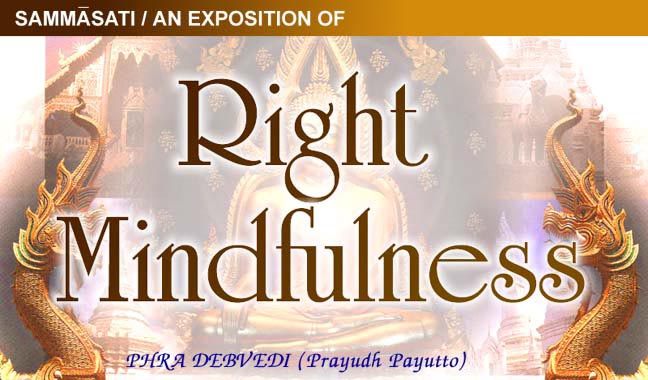Right mindfulness

Right mindfulness (samyak-smṛti / sammā-sati),
also translated as "right memory", "right awareness" or
"right attention". Here, practitioners should constantly keep their
minds alert to phenomena that affect the body and mind. They should be mindful
and deliberate, making sure not to act or speak due to inattention or
forgetfulness. In the Pali Canon, it is explained thus:
And what, monks, is
right mindfulness?
(i) There is the case where a monk remains focused on the body in
and of itself—ardent, aware, and mindful—putting away greed and distress with
reference to the world.
(ii) He remains focused on feelings in and of themselves—ardent,
aware, and mindful—putting away greed and distress with reference to the world.
(iii) He remains focused on the mind in and of itself—ardent,
aware, and mindful—putting away greed and distress with reference to the world.
(iv) He remains focused on mental qualities (dhammesu) in and of themselves—ardent, aware, and mindful—putting away
greed and distress with reference to the world.
This, monks, is called
right mindfulness.

Although the above instruction is given to the male monastic
order, it is also meant for the female monastic order and can be practiced by
lay followers from both genders.
Bhikkhu Bodhi, a monk of the Theravada tradition, further
explains the concept of mindfulness as follows:
The mind is deliberately
kept at the level of bare attention, a detached observation of what
is happening within us and around us in the present moment. In the practice of
right mindfulness the mind is trained to remain in the present, open, quiet,
and alert, contemplating the present event. All judgments and interpretations have
to be suspended, or if they occur, just registered and dropped.
The Maha Satipatthana Sutta also teaches that by mindfully
observing these phenomena, we begin to discern its arising and subsiding and
the Three Characteristics of Dharma in direct experience, which leads to the
arising of insight and the qualities of dispassion, non-clinging, and release.
Right concentration

Right concentration (samyak-samādhi / sammā-samādhi),
as its Sanskrit and Pali names indicate, is the practice of concentration (samadhi).
It is also known as right meditation.[citation needed]As such, the
practitioner concentrates on an object of attention until reaching full
concentration and a state of meditative absorption (jhana). Traditionally, the practice of samadhi can be developed through mindfulness of
breathing (anapanasati), through visual objects (kasina), and through repetition of phrases (mantra). Samadhi is used to suppress the five hindrances in order to enter into jhana. Jhana is an
instrument used for developing wisdom by cultivating insight and using it to
examine true nature of phenomena with direct cognition. This leads to cutting
off the defilements, realizing the dhamma and, finally, self-awakening. During
the practice of right concentration, the practitioner will need to investigate
and verify their right view. In the process right knowledge will arise,
followed by right liberation. In the Pali Canon, it is explained thus:
And what is right
concentration?

(i) Herein a monk aloof from sense desires, aloof from unwholesome
thoughts, attains to and abides in the first meditative absorption [jhana],
which is detachment-born and accompanied by applied thought, sustained thought, joy, and bliss.
(ii) By allaying applied and sustained thought he attains to, and
abides in the second jhana, which is inner tranquillity, which is unification (of the mind), devoid of applied and sustained thought, and
which has joy and bliss.
(iii) By detachment from joy he dwells in equanimity, mindful, and
with clear comprehension and enjoys bliss in body, and attains to and abides in
the third jhana, which the noble ones [ariyas] call "dwelling in equanimity,
mindfulness, and bliss".
(iv) By giving up of bliss and suffering, by the disappearance
already of joy and sorrow, he attains to, and abides in the fourth jhana, which
is neither suffering nor bliss, and which is the purity of equanimity —
mindfulness.
This is called right
concentration.
Although this instruction is given to the male monastic order, it
is also meant for the female monastic order and can be practiced by lay
followers from both genders.
According to the Pali and Chinese canon, right concentration is
dependent on the development of preceding path factors:
The Blessed One said:
"Now what, monks, is noble right concentration with its supports and
requisite conditions? Any singleness of mind equipped with these seven factors
— right view, right resolve, right speech, right action, right livelihood, right
effort, and right mindfulness — is called noble right concentration with its
supports and requisite conditions.
—Maha-cattarisaka Sutta
Acquired factors
In the Mahācattārīsaka Sutta which appears in the Chinese and Pali canons, the Buddha
explains that cultivation of the noble eightfold path leads to the development
of two further factors, which are right knowledge, or insight (sammā-ñāṇa),
and right liberation, or release (sammā-vimutti). These two factors fall
under the category of wisdom (paññā).
Right knowledge and
right liberation

Right knowledge is seeing things as they really are by direct
experience, not as they appear to be, nor as the practitioner wants them to be,
but as they truly are. A result of Right Knowledge is the tenth factor - Right
liberation.
These two factors are the end result of correctly practicing the noble
eightfold path, which arise during the practice of right concentration. The
first to arise is right knowledge: this is where deep insight into the ultimate
reality arises. The last to arise is right liberation: this is where
self-awakening occurs and the practitioner has reached the pinnacle of their
practice.
No comments:
Post a Comment